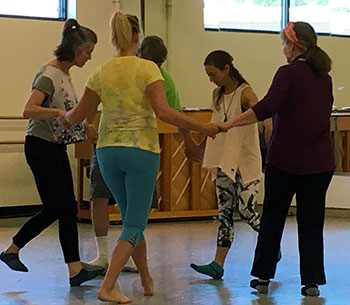Rhythm and Grace
Parkinson's Patients Strengthen Balance and Creativity
By Mark Couch
 (December 2017) Brian Hyde was floating like an astronaut, his arms aloft and his legs akimbo. With his eyes closed, he drifted gently through space.
(December 2017) Brian Hyde was floating like an astronaut, his arms aloft and his legs akimbo. With his eyes closed, he drifted gently through space.
It was just a typical Monday lunch routine for Hyde and others who gather at Colorado Ballet’s rehearsal studio near downtown Denver for a round of exercises designed to help people with Parkinson’s disease strengthen their bodies, improve their balance and steady their gait.
The program, called Rhythm and Grace: Dance for PD, is provided by the Colorado Ballet and the Parkinson Association of the Rockies with support from the University of Colorado School of Medicine Physical Therapy Program.
Taught by Sharon Wehner, principal ballerina for Colorado Ballet, and Robyn Gisbert, PT, DPT, assistant professor in the School of Medicine’s Physical Therapy Program, participants lead and follow dance movements. With live, improvised music the participants apply elements of narrative and imagery with artistry and graceful movement.
At the same time, the participants are addressing such Parkinson’s-specific concerns as balance, flexibility, coordination, isolation and depression. Whether seated in chairs, balancing at a barre or moving across the floor, participants explore elements of modern dance, ballet, tap, and other dance forms.
Best of all, there’s no pressure to perform for a partner or an audience. All participants are working together in dreaming up the moves and guiding each other through the routines.
“You have to let the music tell you when you’re ready for it,” said Hyde, who was diagnosed with Parkinson’s about 13 years ago. “I’m trying to get my head around it like an engineer would, trying to understand how this works, but what I’m trying to do at the same time is let go and let the music lead. If you’re letting go and you’re dancing, then the music is just guiding your body. I want to get to that stage because I think the music knows better than my brain does.”
For Hyde, the creativity the class nurtures is a bonus. The practical impact of improving his balance and waking his consciousness about his body’s movement has allowed for a better quality of life.
The dance movements of Rhythm & Grace put participants through many motions, whether imagining that they are dragging a ball and chain, floating like an astronaut, or catwalking down a fashion runway.
“I’ve had the experience of going hiking with my son and going around the corner on a trail and I could walk right off it if I’m not paying close attention to where my weight is, so I have to be much more conscious of where my weight is and dancing is about moving your weight back
and forth and knowing where it is and good dancers do it instinctively,” Hyde said.
Deborah Clendenning, who lives in Denver, has been participating in the program for three-and-a-half years.
“When I first came I could barely sit in a chair without support and I couldn’t do any of the moves,” said Clendenning, who was diagnosed with motor-neuron disease 15 years ago. “It’s made a huge, huge difference. I love it! So now I dance better than I walk. It’s true.”
The Rhythm & Grace program is adapted from the Dance for PD model created by the Mark Morris Dance Group and the Brooklyn Parkinson Group. That model has been offered in more than 40 communities in the United States and Europe.
Wehner and Gisbert have been teaching the Rhythm and Grace class at the Colorado Ballet since it started several years ago. So far, about 50 people have participated.
“I was just fascinated by how movement and dance could be healing,” said Wehner, who has been with Colorado Ballet for 22 years and will be retiring from the troupe after the current season. And Gisbert, who has been a clinician for 25 years, says she enjoys the artistry that dance conveys in physical movement.
Wehner said she plans to continue collaborating with Gisbert on other efforts to incorporate dance as a form of therapy for other patients.
“We’ll continue this class and probably even be expanding it more,” Wehner said. “Robin and I are talking about taking this kind of model and creating something for people recovering from cancer. That’s what we’d really like to do.”